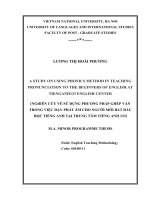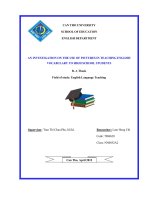046 the history of english in ten minutes
Bạn đang xem bản rút gọn của tài liệu. Xem và tải ngay bản đầy đủ của tài liệu tại đây (116.05 KB, 1 trang )
Prof. Francisco Zabala - 2016
1
The History of English in Ten Minutes
Activity 1:
1.
2.
3.
Watch the video (or listen to the audio file).
Look at the .s. sounds in bold. How
ow would you describe the allophone you hear?
Listen to the text again and focus on the shaded areas. What’s special about them?
The History of English in Ten Minutes
Chapter ten: Global English, or whose language is it anyway
In the fifteen hundred years since the Roman’s left Britain, English has
ha shown
own a unique ability to absorb,
evolve, invade and, if we’re honest, steal. After foreign settlers got it
i started, it
i grew into a fully-fledged
language all of its own, before leaving home and travelling the world, first via the high seas, then via the
high speed broadband connection,
onnection, pilfering words from over 350 languages and establishing itself
i
as a
global institution. All this despite
pite a written
wri
alphabet that bears no correlation to how it sounds and a
system of spelling that even Dan Brow
rown couldn’t decipher. Right now around one
o
point five billion people
speak English. Of these about a quarter are native speakers, a quarter speak it as their second language,
and half are able to ask for directions to a swimming pool. There’s Hinglish – which is Hindi-English,
Chinglish – which is Chinese-English
English and Singlish – which is Singaporean English – and not that bit
when they speak, in musicals.
usicals. So in
i conclusion, the language has got so little to do with England these
days, it may well be time to stop calling it ‘English’. But if someone does think up a new name for it, it
should probably be in Chinese.
TIPS:
•
Very often, .s. is optionally replaced by a glottal stop (Z>\) when it’ss in syllable-final
syllable
position before a
consonant sound (normally, not .s.) or silence.
•
Sounds tend to adapt to their neighbours. This optional process is called assimilation. In general, an
alveolar consoant adopts the place of articulation of the following consonant.
•
You don’tt have to show assimilations or glottal stops in your transcriptions (unless you’re
you asked to).
/ðə
/ðə ˈhɪstri əv ˈɪŋɡlɪʃ
ɡlɪʃ | ɪn ˈten ˈmɪnɪts ||
ˈtʃæptə
æptə ˈten || ˈɡləʊbl
ɡləʊbl ˈɪŋɡlɪʃ | ɔː ˈhuːz ˈlæ
ˈlæŋɡwɪdʒ
ŋɡwɪdʒ ɪz ɪt | ˈeniweɪ
eniweɪ ||
ɪn ðə ˈfɪfˈtiːn ˈhʌndrəd ˈjɪəz | ˈsɪns ðəə ˈrəʊmənz ˈleft ˈbrɪtn | ˈɪŋɡlɪʃ | həʒ ˈʃəʊn ə juːːˈniːk əˈbɪləti | tu əbˈzɔːb |
ɪˈvɒlv | ɪnˈveɪd | ən ɪf wɪər ˈɒnəst | ˈstiːl || ˈɑːftə
ˈ
ˈfɒrən ˈsetləz ˈɡɒt ɪʔ ˈstɑːtɪd | ɪk ˈɡruː | ˈɪntu ə ˈfʊli ˈfledʒ(d)
ˈlæŋɡwɪdʒ
ɪdʒ | ˈɔːl əv ɪts ˈəʊn || bɪˈfɔː ˈliːvɪŋ ˈhəʊm | ən ˈtrævəlɪŋ ðə ˈwɜːld | ˈfɜːs(tt) ˈva(ɪ)ə ðə ˈhaɪ ˈsiːz || ðen
ˈva(ɪ)ə ðə ˈhaɪ ˈspiːd ˈbrɔːbbæŋ(g) kəəˈnekʃn | ˈpɪlfərɪŋ ˈwɜːdz | frəm ˈəʊvə ˈθriː ˈhʌʌndrəd ən ˈfɪfti ˈlæŋɡwɪdʒɪz
| ən ɪˈstæblɪʃɪŋ ɪʔˈself | əz ə ˈɡləʊbl
əʊbl ˈɪnstɪˈtjuːʃn || ˈɔːl ˈðɪs | dɪˈspaɪt ə ˈrɪʔn ˈælfəbet | ðəʔ ˈbeəz ˈnəʊ
ˈkɒrəˈleɪʃn | tə ˈhaʊ ɪt ˈsaʊn(d)z | ənn ə ˈsɪstəm əv ˈspelɪŋ | ðət ˈiːvn ˈdæm ˈbraʊŋ ˈkkʊdn(t) dɪˈsaɪfə || ˈraɪʔ ˈnaʊ |
əˈraʊn(d) ˈwʌm ˈpɔɪnt ˈfaɪv ˈbɪljəm ˈpiːpl | ˈspiːk ˈɪŋɡlɪʃ || ˈɒv ˈðiːz | əˈbaʊt ə ˈkw
kwɔːtə | ə ˈneɪtɪv ˈspiːkəz | ə
ˈkwɔːtə ˈspiːk ɪt əz ðeə ˈsekənd ˈlæŋŋɡwɪdʒ | ən ˈhɑːf | ər ˈeɪbl | tu ˈɑːsk fəə dɪˈrekʃnz
dɪˈrekʃn tu ə ˈswɪmɪŋpuːl || ðəz
ˈhɪŋɡlɪʃ | wɪtʃ ɪz ˈhɪndi ˈɪŋɡlɪʃ
ɪʃ || ˈtʃɪŋɡlɪʃ | wɪtʃ ɪz ˈtʃaɪˈniːz ˈɪŋɡlɪʃ
ɪʃ || ən ˈsɪŋɡlɪʃ | wɪtʃ ɪz ˈsɪŋəˈpɔːriən ˈɪŋɡlɪʃ ||
ən ˈnɒʔ ðæʔ ˈbɪʔ wen ˈðeɪ ˈspiːk | ɪm
m ˈmjuːzɪklz || səʊ ˈɪŋ kəŋˈkluːʒn | ðə ˈlæŋɡwɪdʒ
ɪdʒ əz ˈɡɒʔ
ˈɡɒ ˈsəʊ ˈlɪtl tə ˈduː
wɪð ˈɪŋɡlənd | ðiːz ˈdeɪz | ɪʔ meɪ ˈwel
wel | bi ˈtaɪm tə ˈstɒp ˈkɔːlɪŋ ɪt ˈɪŋɡlɪʃ
ɪʃ || bət ɪf ˈsʌmwʌn ˈdʌz ˈθɪŋk ˈʌp ə
ˈnjuː ˈneɪm fər ɪt | ɪt ʃəb ˈprɒbəbli | bi ɪn tʃaɪˈniːz/









